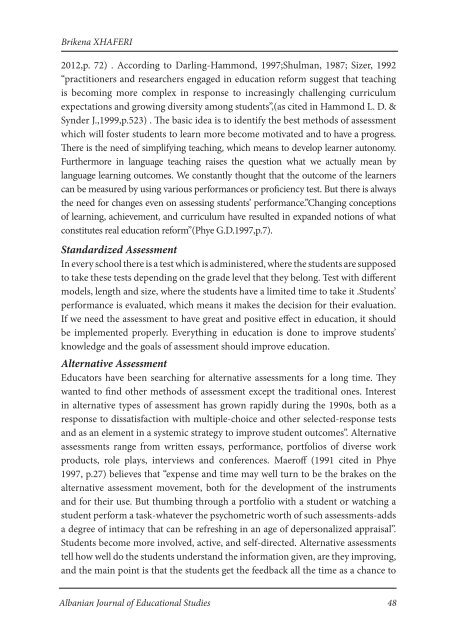Download - qendra per arsim demokratik
Download - qendra per arsim demokratik
Download - qendra per arsim demokratik
Create successful ePaper yourself
Turn your PDF publications into a flip-book with our unique Google optimized e-Paper software.
Brikena XHAFERI2012,p. 72) . According to Darling-Hammond, 1997;Shulman, 1987; Sizer, 1992“practitioners and researchers engaged in education reform suggest that teachingis becoming more complex in response to increasingly challenging curriculumexpectations and growing diversity among students”,(as cited in Hammond L. D. &Synder J.,1999,p.523) . The basic idea is to identify the best methods of assessmentwhich will foster students to learn more become motivated and to have a progress.There is the need of simplifying teaching, which means to develop learner autonomy.Furthermore in language teaching raises the question what we actually mean bylanguage learning outcomes. We constantly thought that the outcome of the learnerscan be measured by using various <strong>per</strong>formances or proficiency test. But there is alwaysthe need for changes even on assessing students’ <strong>per</strong>formance.”Changing conceptionsof learning, achievement, and curriculum have resulted in expanded notions of whatconstitutes real education reform”(Phye G.D.1997,p.7).Standardized AssessmentIn every school there is a test which is administered, where the students are supposedto take these tests depending on the grade level that they belong. Test with differentmodels, length and size, where the students have a limited time to take it .Students’<strong>per</strong>formance is evaluated, which means it makes the decision for their evaluation.If we need the assessment to have great and positive effect in education, it shouldbe implemented pro<strong>per</strong>ly. Everything in education is done to improve students’knowledge and the goals of assessment should improve education.Alternative AssessmentEducators have been searching for alternative assessments for a long time. Theywanted to find other methods of assessment except the traditional ones. Interestin alternative types of assessment has grown rapidly during the 1990s, both as aresponse to dissatisfaction with multiple-choice and other selected-response testsand as an element in a systemic strategy to improve student outcomes”. Alternativeassessments range from written essays, <strong>per</strong>formance, portfolios of diverse workproducts, role plays, interviews and conferences. Maeroff (1991 cited in Phye1997, p.27) believes that “expense and time may well turn to be the brakes on thealternative assessment movement, both for the development of the instrumentsand for their use. But thumbing through a portfolio with a student or watching astudent <strong>per</strong>form a task-whatever the psychometric worth of such assessments-addsa degree of intimacy that can be refreshing in an age of de<strong>per</strong>sonalized appraisal”.Students become more involved, active, and self-directed. Alternative assessmentstell how well do the students understand the information given, are they improving,and the main point is that the students get the feedback all the time as a chance toAlbanian Journal of Educational Studies 48


